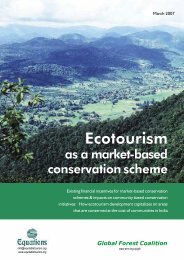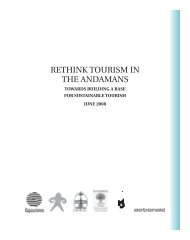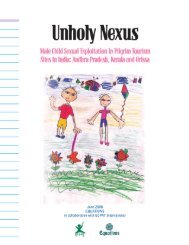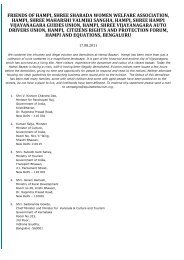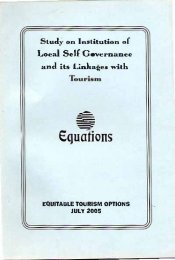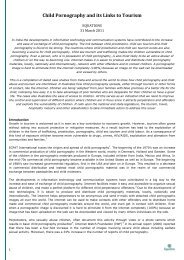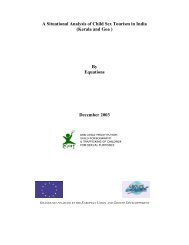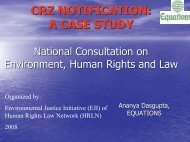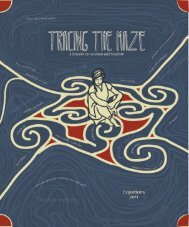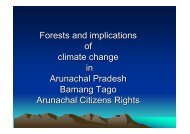Nilgiris Biosphere Reserve - Equitable Tourism Options
Nilgiris Biosphere Reserve - Equitable Tourism Options
Nilgiris Biosphere Reserve - Equitable Tourism Options
Create successful ePaper yourself
Turn your PDF publications into a flip-book with our unique Google optimized e-Paper software.
+ 15% resort use firewood for heating the water, 45% use geysers,<br />
5% use solar energy, 10% use wood and Geyser.<br />
+ Per day water usage of 23 resorts are put to gather 600000 litres.<br />
Case study #2:<br />
NAGARAHOLE - adivasis, rights and tourism<br />
The profile of Nagarhole<br />
The Nagarhole National Park is located in the Kodagu and Mysore districts<br />
of Karnataka. The park borders the Bandipur Wildlife Sanctuary in the<br />
southeast and the Waynad Wildlife Sanctuary in the southwest. To the west<br />
it is separated from the Brahmagiri Wildlife Sanctuary by coffee plantations.<br />
This park got its name from the Nagar Hole ( , Snake River' In Kannada),<br />
which runs eastwards through its centre. Nagarhole is part of the 4500 sq.<br />
kms Nilgiri <strong>Biosphere</strong> <strong>Reserve</strong>. It lies between latitudes 11 ° 45'_ 12 ° 15' north<br />
and longitudes 76 ° 5'-76 ° 25 east. The terrain is gently undulating with a<br />
mean elevation of 800-850 metres.<br />
The sanctuary was constituted on 2n d July 1955 with an area of 57155<br />
hectares. In 1972, the Government of Karnataka declared 130 sq. kms as<br />
the Nagarhole Game Sanctuary. The process of reclassifying, the<br />
sanctuary into a national park commenced vide Notification No. FED 195<br />
FWL 82 of 16 th March 1983 on 1 st April 1983. It increased its extent to<br />
643.39 sq. kms including 7 ranges i.e. Kakanakote, Metikoppe,<br />
Veeranahosahalli, Kalaholla, Nagarhole, Mathigod and Murukal on 8 th<br />
December 1983. The park was renamed as the Rajiv Gandhi National Park<br />
on 13 th May 1992. It covers an area of 643.39 sq. kms. 192 sq. kms. has<br />
been identified as the core zone, a tourism zone (in two parts) and a<br />
restoration zone (areas not located on the map as yet). The restoration<br />
zone is to comprise of those areas which have been totally degraded and<br />
need complete protection.<br />
Nagarhole resembles the Deccan Peninsula biogeographic zone ir.<br />
topography, vegetation and animal life.<br />
N"dilgiris : Fading Glory 28



